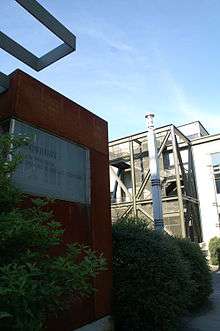Natural Capital Center


The Natural Capital Center, formally known as the Jean Vollum Natural Capital Center and informally as the Ecotrust Building, is a notable example of green building in Portland, Oregon, United States. It was the first historic redevelopment in the U.S. to receive a gold-level Leadership in Energy and Environmental Design (LEED) award from the U.S. Green Building Council.[1] The building houses a unique mix of public and private, nonprofit and for-profit tenants, all of whom espouse social and environmental missions.[2]
History and redevelopment
The timber and brick structure that is now Natural Capital Center was built in 1895 by the J. McCraken Company. The building's recessed rounded-arch entry, arched window openings and massive heft exemplify the Romanesque style inspired by architect Henry Hobson Richardson. Situated between two railroad freight yards, the McCraken wholesale company distributed Monterey sand, Tenino sandstone and other building supplies. In the 1930s, the building became known as the Central Truck Terminal and then from 1941 to 1997 housed the Rapid Transfer & Storage Company (von Hagen, 2003).
In 1998, Ecotrust, a nonprofit conservation organization, purchased the building with a donation from then board member Jean Vollum. Redevelopment of the 70,000-square-foot (6,500 m2) building cost $12.4 million and was completed in September 2001. The idea that a conservation organization would shift focus from protecting forests and watersheds to participating in urban renewal was an unusual and controversial one. A primary champion was then Ecotrust board member Jane Jacobs, author of The Death and Life of Great American Cities. Ecotrust council member Stewart Brand, author of How Buildings Learn, was another key supporter. Soon after the building's purchase, he guided a charrette to discuss potential systems designs and programmatic linkages for the building. That the environmental movement should address the urban environment was later one of the key themes in Brand's 2005 article "Four Heresies." [3]
Re-opened to the public in 2001, the building was named the Natural Capital Center to reflect the ideas in ecological economics that nature's services are basic to human existence and that natural capital is, along with financial and other forms of capital, a fundamental means of production. As the first LEED gold-certified building in the Pacific Northwest, the building has become an icon of Portland, Oregon's leadership in the field of sustainability. The mix of "green" tenants in the building—including Patagonia, Hot Lips Pizza, ShoreBank Pacific, Portfolio 21, and the City of Portland's Office of Sustainable Development—has gained much attention and been cited as an inspiration for other developments planned around the country, including the Green Exchange in Chicago.[4]
It is located at 721 NW 9th Avenue, Portland, OR 97209.
Features
- Embodied energy - Owing to the large amount of energy that goes into materials manufacture, reuse of existing buildings is an important consideration in energy conservation. At the Natural Capital Center opening ceremony, Patagonia founder Yvon Chouinard said, "If you're going to buy clothing, the most responsible thing you can do is go to the Salvation Army. And if you're going to open a new business, the most responsible thing you can do is find an old building and restore it." [5]
- Deconstruction - An annex to the original building was deconstructed, and throughout the redevelopment, 98% of all debris was reused, recycled or reclaimed - a record for the city of Portland.[6]
- Stormwater management - The building utilizes a green roof, permeable pavement and bioswales to retain an estimated 95% of the property's stormwater onsite.
- Land use - The building is located in a high density area, with close access to public transportation. The parking lot is used as a farmer's market once a week in the summer.
- Materials - Two-thirds of the new wood used in the building was Forest Stewardship Council (FSC) certified.[7] Innovative materials include rubber flooring from post-consumer recycled rubber tires.[8]
- LEED rating - The building received 41 of 69 possible points.[9]
References
- ↑ Libby, Brian. "LEEDing the Way: Natural Capital Center, Viridian Place win environmental 'seal of approval'" Daily Journal of Commerce. Accessed from Green Building Services website, May 10, 2007.
- ↑ BuildingGreen, Inc. "High Performance Buildings Database: Jean Vollum Natural Capital Center, Overview" U.S. Green Building Council, Cascadia Chapter website. Accessed May 10, 2007.
- ↑ Brand, Stewart. "Four Heresies" MIT Technology Review, May, 2005. Accessed May 10, 2007.
- ↑ Schneider, Keith. "SQUARE FEET; In Chicago, a Haven For Green Enterprise" The New York Times, July 25, 2007. Accessed September 4, 2007.
- ↑ Architecture Week. "Historic Warehouse Grows Green" Architecture Week, December 19, 2001. Accessed May 10, 2007.
- ↑ Libby, Brian. "LEEDing the Way: Natural Capital Center, Viridian Place win environmental 'seal of approval'" Daily Journal of Commerce. Accessed from Green Building Services website, May 10, 2007.
- ↑ BuildingGreen, LLC "High Performance Buildings Database: Jean Vollum Natural Capital Center, Materials & Resources" U.S. Green Building Council, Cascadia Chapter website. Accessed May 10, 2007.
- ↑ Frerichs, Eugénie "Materials Guide to the Jean Vollum Natural Capital Center" Ecotrust. Accessed May 10, 2007.
- ↑ BuildingGreen, Inc. "High Performance Buildings Database: Jean Vollum Natural Capital Center, Ratings" U.S. Green Building Council, Cascadia Chapter website. Accessed May 10, 2007.
Further reading
- "Building on Ideas for Urban Conservation." Linda Baker. New York Times. March 4, 2001. Accessed May 10, 2007.
- "Case Study: Ecotrust Building Renovation" Interface Engineering. Accessed May 10, 2007.
- "Historic Preservation and Green Building: A Lasting Relationship." Tristan Roberts. Environmental Building News. January 2007. Accessed May 10, 2007.
- Rebuilt Green: The Natural Capital Center and the Transformative Power of Building. Von Hagen, Bettina, Erin Kellogg and Eugenie Frerichs, editors. 2003, Ecotrust, 120 pages, ISBN 0-9676364-2-6. Accessed May 10, 2007.
External links
- Ecotrust's Natural Capital Center page
- U.S. Green Building Council
- City of Portland's Office of Sustainable Development
- ShoreBank Pacific
- Green Exchange
Coordinates: 45°31′42″N 122°40′50″W / 45.528336°N 122.680437°W